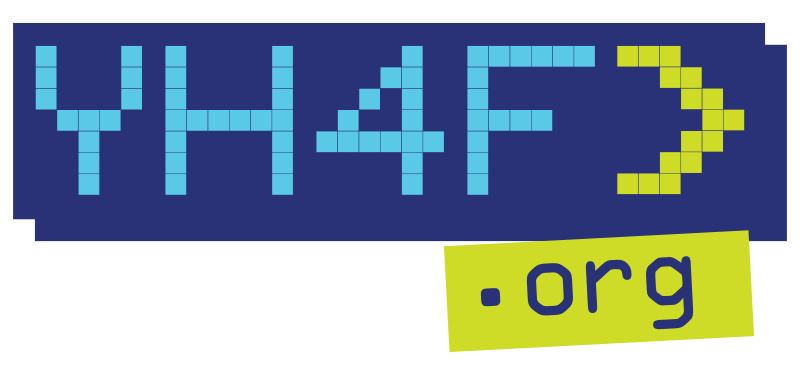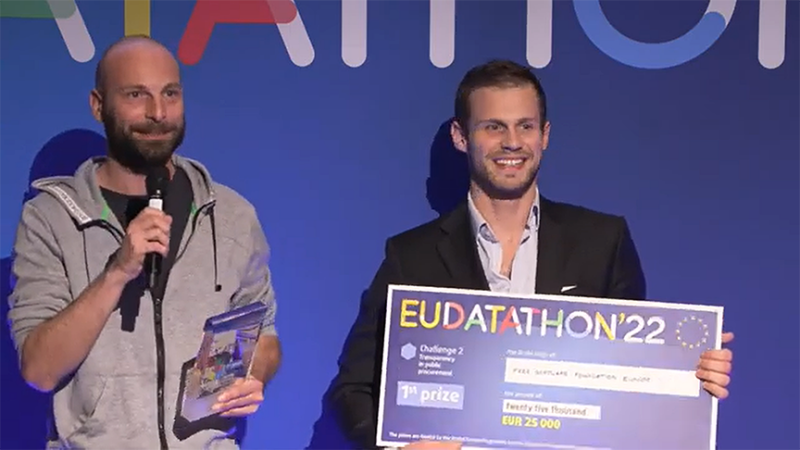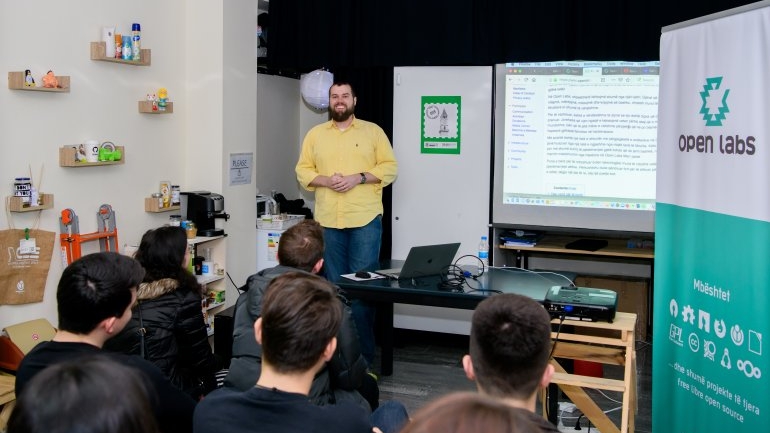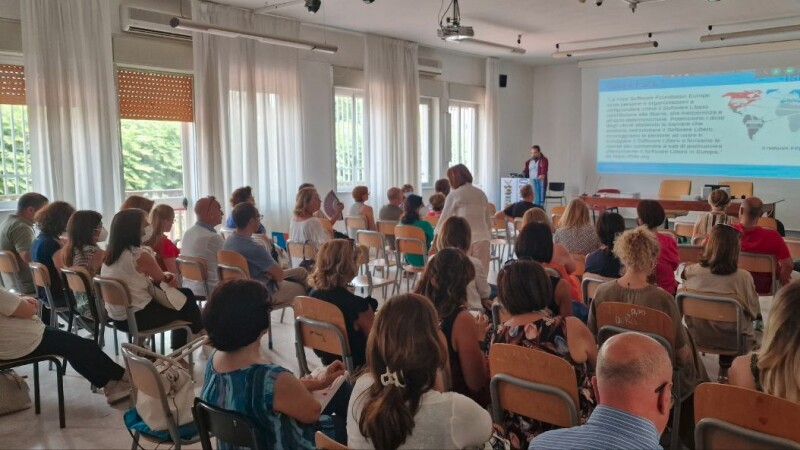✦ Youth Hacking 4 Freedom Winners ✦
After a year of coding and evaluation the Youth Hacking 4 Freedom
competition comes to an end, giving us amazing projects. Who won? The
six winning programs offer sign language transcription, a smart table
robot, a personal assistant, a music tutorial, file sharing, and a
homework manager. All Free Software.
Back in October the FSFE started the Youth Hacking 4 Freedom
competition to inspire the younger generation into software freedom.
We had the pleasure to receive many interesting and inspired projects
from all around Europe. Over a hundred people coming from 25
countries registered for the competition, making it a truly
pan-European event. Now it is the exciting time of the results! The
winners receive a cash prize intended to help them further develop
their programs, or to support their studies. After careful
consideration and interviews, here are the six winners:
Ultimate Hacker Award: Stavros for SignTrack 🥇
Elite Hacker Award: Miquel for Smart Table Assistant
🥈
Awesome Hacker Award: Artur for Aspinwall 🥉
Ultimate Girl Hacker Award: Ekaterina for Music
Companion 🏅
Special Hacker Award: Coming from warzone: Mark for
Sharik 🤍
Youngest Hacker Award: Héctor for LibreHomework ⭐
🥇Ultimate Hacker Award: Stavros for SignTrack
Stavros, 17 year old student from Heraklion, a city in the Greek
island Crete, wins the first prize with a project that amazes both
for its execution and its idea. Signtrack aims to
translate sign language to writing. It is a valuable technology for
people who use sign language to communicate fast with an audience who
do not know sign language. This might help them personally and
professionally. Here is what Stavros has to say for SignTrack.
What does SignTrack do?
Stavros: SignTrack transcribes sign language to text
from a real-time video feed. The model makes predictions on what you
sign instantly. After completing your sentence, an additional
processing layer restructures your sentence to follow grammatical
rules, which are different in sign language. Creating a custom model
requires minimal coding skills. A graphical interface assists you
throughout data collection. And with the power of AutoTrain, training
your model does not require complex adjustments.
How did you come up with the idea?
Stavros: Sign language classes in my school
highlighted the need for sign language recognition as an
accessibility feature. After realizing there was no easy-to-use Free
Software in that field, I decided to develop SignTrack.
What was your experience of the competition?
Stavros: The YH4F competition was a remarkable opportunity to showcase
SignTrack. The openness of the competition suited the idea behind the
project perfectly. Additionally, while working on the project, I
learned more about neural networks, sign language, and Free Software,
all equally important in their way.
🥈 Elite Hacker Award: Miquel for Smart Table Assistant
17-year-old Miquel from Catalonia, Spain, wins the second place with
Smart Table
Assistant, a project with an astonishing aim which includes
software as well as hardware. Miquel created a robot-model intending
to help people with disabilities in the lower extremities. The table can
adapt to the user and makes the meals of the day easier.
How does it work?
Miquel: The Smart Table Assistant can memorize the
route from the starting point, go to the recipient and stay in
position until you give the order to return to the base. It can move
in many directions, thanks to the omnidirectional wheels located on
the platform of the”smart table“. The device contains a remote
control that will perform certain functions, such as the availability
of a removable table, a cellar, turning on the backlight and making
room for the footrest. At the top of the table, it has a built-in
bucket which allows it to be removed after eating, so it can be
easier to clean the utensils used for eating and put it in the
dishwasher.
It looks good, how did you design it?
Miquel: The robot has been designed with good
ergonomics in mind, then the instructions of the table have been
programmed, and after all, it has been applied to the elements
through Arduino. Finally, the mechanisms have been made to make it
work properly. The aesthetics of the product were inspired by the
shape of the pillars of the Sagrada Familia and the projection of
light from its stained glass windows. Most of the structure of this
project has been possible thanks to the 3D printing technology.
🥉Awesome Hacker Award: Artur for Aspinwall
16-year-old Artur from Poland is an active Free Software supporter,
contributing to many projects such as Alpine Linux and postmarketOS,
as well as translating. He wins the third place of the competition
with Aspinwall, an
easy way to turn old touchscreen devices into smart displays.
What does Aspinwall do?
Artur: Aspinwall is a user interface that can turn a
tablet or another mobile device into a personal assistant, showing
all of the most important information at a glance. The information
that is displayed can be customized through widgets, which can
contain anything - a to-do list, weather information, notifications…
It’s a fun way to repurpose old devices that would otherwise collect
dust on a shelf or end up in a landfill.”
How did you come up with Apsinwall?
Artur: When I first came across the concept of”smart
displays“, it sparked my curiosity - I liked how they looked while
remaining functional, and figured that a similar device could be
quite useful in daily life (for example, in a kitchen, where you may
want to get information about a recipe but don’t have the space/clean
hands to use a full tablet or laptop). My main concern, however, was
that most of these devices were produced by large tech giants known
for their extensive data collection. I felt that we could do better -
so, I started thinking about a Free Software alternative that could
also run on various old devices like tablets, with no expensive new
hardware needed. The idea stayed in my head for a while, but I never
got around to working on it. That’s when I heard about the YH4F
competition - it gave me the push needed to turn my concept into
reality.
How was your experience of the competition?
Artur: I’ve learnt quite a lot during the coding
period. Some of it was technical - I’ve learnt how to use pygobject
and GTK, and improved my Python knowledge. Besides that, though, it
was a good exercise in time management - I had to figure out which
tasks to do and in what order to make it before the deadline. Having
to juggle the time between school and my project was a bit difficult
at times, but I’m still quite happy with how much I managed to do
before I ran out of time. Overall, it’s been a great learning
experience, and I got the motivation to work on a project that’s been
on my mind for quite a while. I’m excited to see what other
participants made for the competition, and to maybe meet them in
Brussels later this year. Thanks to the organizers for such a great
opportunity!
🏅Ultimate Girl Hacker Award: Ekaterina for Music Companion
17-year-old Ekaterina, living in Cyprus, likes to play the piano as
well as programming. Her interests gave her the winning idea: a program helping
the user learn to play music.
What does Music Companion do?
Ekaterina: The program allows the user to get to
know with the basics of music, such as the notes, chords and scales.
By clicking on the different modes and reading the description in the
“?”, you will explore this simple music glossary and acquire
knowledge of what is a scale, what are the different chords and other
music elements. In addition you will be able to hear how it sounds!
How was your experience of the competition?
Ekaterina: Taking part in this competition was personally a big step as before it I have never ever programmed something and I did not have knowledge to do so. During the project I learned a lot more about programming concepts, how can I implement the modules and generally the programming language – Python.
🤍 Special Hacker Award: Coming from warzone: Mark for Sharik
When we announced the Youth Hacking 4 Freedom competition in 2021 we
welcomed people from all over Europe to participate. We did not
anticipate that during the coding period some of the participants
would find themselves in a warzone. Acknowledging that not everyone
could participate in peace, we give out the Special Hacker Award.
Mark from Ukraine wins the Special Hacker Award with his file-sharing
program.
What it Sharik?
Mark: Sharik is a simple, cross-platform solution for sharing files within a local network. While Sharik is extremely simple, pretty, and most importantly libre, it is also very versatile and minimalistic.
How did you come up with the idea?
Mark: Having limited access to a high-speed
internet, it was common for me and my friends to share music, apps,
some documents for school, and other kinds of files directly via
bluetooth or numerous apps. Even though the task was extremely
simple, software that could do it was slow, full of ads, and frankly
ugly. That’s why, having some experience in software development, I
decided to build my own app.
How was your experience of the competition?
Mark: This competition showed me that building a
Free Software project is great, but advertising it should be a
priority. As the project becomes more popular, it attracts more
contributors, making the project better as a result.
⭐ Youngest Hacker Award: Héctor for LibreHomework
15-year-old Héctor from Spain impressed with his LibreHomework and
won the Youngest Hacker Award. Héctor is a GNU/Linux user and a Free
Software enthusiast. Here is what he shares about his project.
What is LibreHomework?
Héctor: LibreHomework is a Free Softwaretool made
for students and by students. Schedule tasks and get notified, write
down exams, organize your documents and lock your screen to help you
focus on your tasks. The project is also available in 6 different
languages. In the upcoming update you’ll also be able to meet other
students thanks to LibreHomework’s network. It’s still a work in
progress so feel free to check it out and suggest new features!
How did you come up with the idea?
Héctor: Most of students have problems organizing
their tasks, so why not make it easier? There are already tools for
that, but is it any of them Free Software? How many features does it
have? Are they too simple or too complicated? That’s why I created
LibreHomework.
How was your experience of the competition?
Héctor: I initially discovered this competition
thanks to my IT teacher. Before that I was already looking for a new
exciting project to work on, so this opportunity was perfect. The
idea was born because I felt students lack (good enough) Free
Software tools. The concept is quite simple but as I had enough time
I decided to expand it into something bigger, so I ended up learning
some technical stuff such as server management and web development.

More projects
There are many more cool projects submitted in the Youth Hacking 4
Freedom competition. We want to share more on what young hackers came
up with. Stay tuned for more news in the next weeks!
Support FSFE



 Francesco Bonanno presenting the ‘Public Money? Public Code!’ initiative. Caltanissetta, Italy, September 2022.
Francesco Bonanno presenting the ‘Public Money? Public Code!’ initiative. Caltanissetta, Italy, September 2022.
